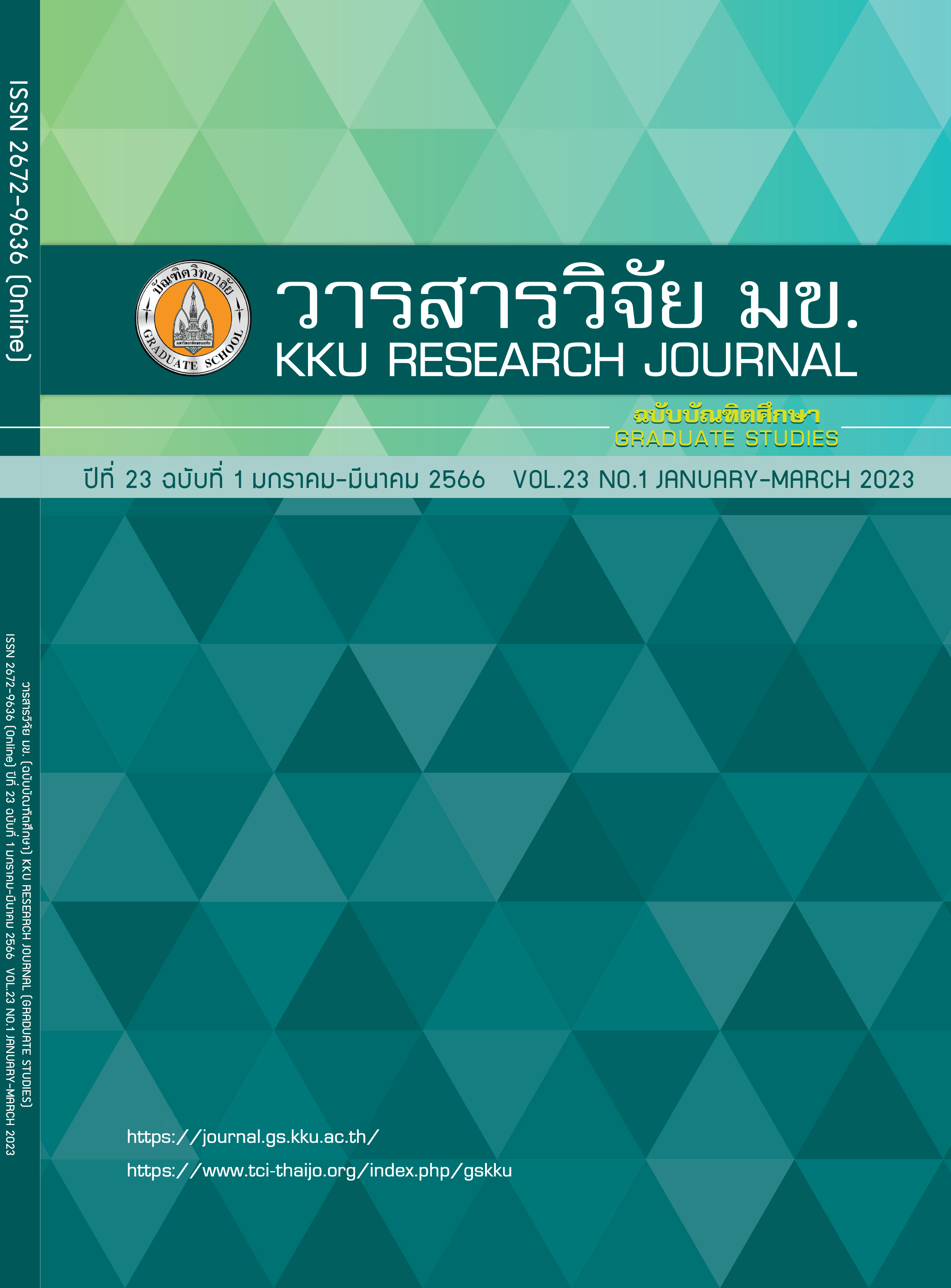Factors Affecting Pedestrian Gap Acceptance Bahavior at Mid-Block Crosswalks in Khon Kaen University
Keywords:
Gap acceptance, Pedestrian, Mid-block CrosswalkAbstract
Pedestrian crashes with fatal injuries are on the rise. For crossing safety, gap acceptance behavior is critical. Therefore, this study aims to reveal pedestrian crossing behavior at mid-block crosswalks, as well as the factors that influence gap accepting behavior. The study observed and recorded 711 crossing behaviors, including 2,915 accepted/rejected gaps on 9 crosswalks, located in Khon Kaen University. The data was analyzed using descriptive statistics and a binary logistic regression model. The results revealed that rolling gaps crossings make for one-third of all crossings and the same number applied for crossing outside of a crosswalk. Drivers yielded to pedestrians in only 9% of all crossings. Run, walk and run, waiting in the middle of the road, wide gaps, and gap from vehicles in the near lane are all elements that increase the likelihood of accepting a gap. Using a mobile phone, carrying luggage, higher vehicle speed, and cross more traffic lanes, on the other hand, are all factors that decrease the likelihood of accepting gaps.
References
National Center for Statistics and Analysis. Preview of Motor Vehicle Traffic Fatalities In 2019; Traffic Safety Facts Research Note. 2020; DOT HS 813 021.
World Health Organization. GLOBAL STATUS REPORT ON ROAD SAFETY 2018. Geneva, Switzerland; 2018.
Office of transport and traffic policy and planning. Road accident situation analysis report of the Ministry of Transport. 2017. Thai.
Office of transport and traffic policy and planning. Road accident situation analysis report of the Ministry of Transport. 2018. Thai.
Office of transport and traffic policy and planning. Road accident situation analysis report of the Ministry of Transport. 2019. Thai.
ThaiRoads Foundation. Report on the situation of road accidents in Thailand 2016-2017. Thai.
ThaiRoads Foundation. Vulnerable Road Users: VRU. Bangkok: Triple Group; 2019. Thai.
Naser MM, Zulkiple A, Albargi WA, Khalifa NA, Danail BD. Modeling pedestrian gap crossing index under mixed traffic condition. J Saf Res. 2017; 63: 91-98.
Theofilatos A, Ziakopoulos A, Oviedo-Trespalacios O, Timmis A. To cross or not cross? Review and meta-analysis of pedestrian gap acceptance decisions at midblock street crossings. J Transp Heal. 2021; 22: 101108
Kadali BR, Vedagiri P. Role of number of traffic lanes on pedestrian gap acceptance and risk taking behaviour at uncontrolled crosswalk locations. J Transp Heal. 2020; 19: 100950.
Kadali BR, Vedagiri P, Rathi N. Models for pedestrian gap acceptance behaviour analysis at unprotected mid-block crosswalks under mixed traffic conditions. Transp Res Part F. 2015; 32: 114-116.
Kadali BR, Vedagiri P. Effect of Vehicular Lanes on Pedestrian Gap Acceptance Behaviour. Proc Soc Beha Sci. 2013; 104: 678-687
Zhao J, Malenje JO, Tang Y, Han Y. Gap acceptance probability model for pedestrians at unsignalized mid-block crosswalks based on logistic regression. Accid Anal Prev. 2019; 129: 76-83
Vasudevan V, Mehta M, Dutta B. Pedestrian temporal gap acceptance behavior at unsignalized intersections in Kanpur, India. Transp Res Part F. 2020; 74: 95-103.
Pawar DS, Patil GR. Critical gap estimation for pedestrians at uncontrolled mid-block crossings on high-speed arterials. Saf Sci. 2016; 86: 295-303
Alver Y, Onelcin P, Cicekli A, Aty MA. Evaluation of pedestrian critical gap and crossing speed at midblock crossing using image processing. Accid Anal Prev. 2021; 156:106127.
Compare the penalties for each country “If the car doesn't stop to people cross the zebra crossing.” [Internet] 2022 Jan 28; cited 2022 May 1. Available from: https://www.pptvhd36.com/news/%E0%B8%95%E0%B9%88%E0%B8%B2%E0%B8%87%E0%B8%9B%E0%B8%A3%E0%B8%B0%E0%B9%80%E0%B8%97%E0%B8%A8/165225?fbclid=IwAR3_ViwSk2KSvWGFTqrfY2UMoa8D8xtwz1pkbVXWIgc1MpuA4oTx9cQbT2A
Noiruean T, Tachumpa P, Salitkaew P, ChanThep P. A study pedestrian behavior crossroads at signal light: Case study in Chiang Mai. The 25th National Convention on Civil Engineering; 2020; July 15-17; Online Conference. Thai.
Chumuenwa P, Thanasupsin K. Behaviors of Pedestrians at Midblock Crosswalk with Pedestrian Push Button; A Case Study of 4-Lane Road and 6-Lane Road of Suburban in Bangkok. Proceeding of the 20th Graduate Research Conference; 2019; Khon Kean University: Khon Kean. Thai.
Wanishbuncha K, Wanishbuncha T. Using SPSS for Windows analyzing data. Bangkok: Samlada,2018. Thai.
Downloads
Published
Issue
Section
License
Copyright (c) 2023 KKU Research Journal (Graduate Studies)

This work is licensed under a Creative Commons Attribution-NonCommercial-NoDerivatives 4.0 International License.



